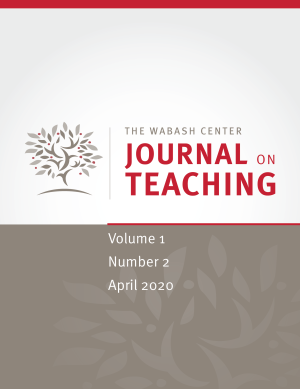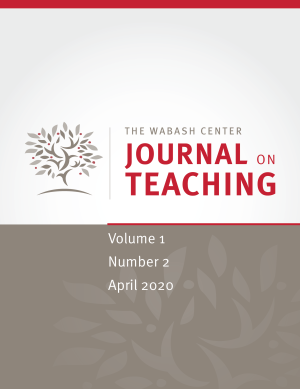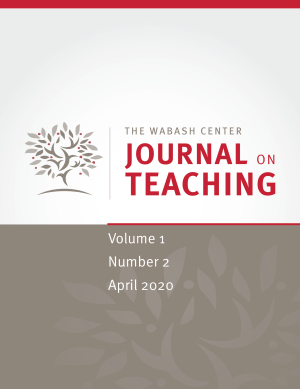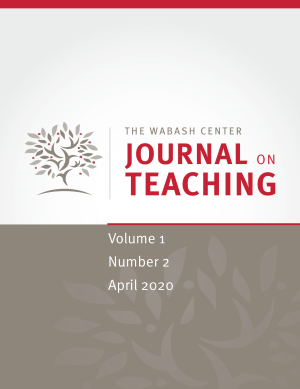Resources
Creating worthwhile experiences for students using a digital platform can provide new, interesting and creative options in teaching. Cultivating the digital imagination will help teaching into the future. Dr. Nancy Lynne Westfield hosts Kwok Pui Lan (Candler School of Theology - Emory University).

Discussion forums in online classrooms are unfortunately named. The name evokes just talking about stuff. This can be a good use of the discussion forum; dialogue is an important part of higher education. The opportunity to test and develop ideas in conversation with trusted colleagues, both classmates and professors—yes, the discussion forum is a place to do that. But, I find I often get into a rut in these forums. I introduce and assign readings, then ask a series of questions to jumpstart a conversation. At its worst, this is about making sure that students are doing the reading and making some sense of it, a kind of accountability busy work. At its best, this is a way to integrate and work critically together with those materials in ways that help them come alive and become true conversation partners for the developing wisdom of my students. I am always looking for other ways to better use these dialogical spaces with students. One of the metaphors that has been helpful for me is to use these spaces for students to “curate” materials for one another. By “curate,” I mean something like this: “to collect, select and present information or items such as pictures, video, music, etc. for people to use or enjoy, using your professional or expert knowledge.” For example, wise curating is what Maria Popova does in her excellent podcast and website, “Brain Pickings” (https://www.brainpickings.org/). Curating in discussion forums can take all sorts of forms, depending on your purposes and the disciplined knowledges you are attempting to teach. Here are some of the ways I have used it as a religious educator and practical theologian: • Curating Examples from Daily Life: When I am reading dense theoretical pieces with students (imagine Pierre Bourdieu or Paulo Freire), I invite them to find a website, image, or current event that illustrates one of the key theoretical concepts in the reading. This brings about a great deal of reflection on the concepts as the students try to imagine what might serve as a useful example of the concept in action. They often consider and reject many concepts as they try to find the one they will share, thus generating a more careful review of the reading. They post a link to the event or website and explain the concept that they see it illustrating to their colleagues. This has the subtle effect of helping them imagine that engaging these theories is not to demonstrate their competence for a grade, but to gain tools to better understand how the world works. It also serves as a test for the theories as we begin to see which ones have heuristic value making sense of daily life. • Curating Images: When we are working in my practical theology class on forming theological questions grounded in human experience, I invite students to offer a photographic image from their home or neighborhood that raises significant theological questions for them. As the collection of images are curated, they begin to see how questions are related to particular contexts and communities, as well as begin to think about what makes a question theological at all. Their colleagues’ reflections on their images generate a range of different theological questions and demonstrate the role of perspectival framing not just in the answering of questions, but also in their initial framing. • Curating Practices: In a religious education class I ask students to search the web for examples of contemporary religious educational practice happening inside or outside of communities of faith. They share the examples and analyze them, naming their strengths and limitations and how they might imagine using them in their own practice as educators. This not only gives them practice in identifying and analyzing resources, but also expands all of our knowledge about what is currently happening in the practice of the field and how it relates to the academic texts we have been reading. • Curating Stereotypes, or Common Misunderstandings and Misrepresentations: In youth ministry classes, I have students curate examples of the ways that adolescents are stereotyped and used as tropes in popular culture. They then take apart those stereotypes and tropes and compare them to what we’ve gleaned from developmental, sociological, and cultural studies of adolescence we have been reading. This enables them to identify where the tropes may have roots in those theories, but also where they have become distorted. Curating would serve different purposes in different disciplines, and I am sure you have creative ideas here. Students might curate examples of a particular Biblical text or historical event in visual art, poetry, literature, or song and talk about the interpretive choices made in that artwork. They might collect examples of practices from religious traditions in popular culture, or on YouTube, and analyze how they are represented in those forums in relation to the academic interpretations you are reading about those same practices. They might curate helpful video lectures or social media posts of an author you are reading, giving them a chance to listen to their embodied voices and discover something of the human behind the academic work you are reading. They might find examples of how historical events that you are studying are depicted on websites intended for elementary or middle schoolers and talk about the implications of historiographical choices made in those settings. They might curate academic articles that build on the theory you are reading in an area that is relevant to their own vocational path. The beautiful thing about online discussion forums is that curating, posting a photo or link, and then writing a brief analysis of the artifact, is very easy to construct. It leverages the investigative power of the students and allows them to follow their interests, integrate knowledge, engage in application and analysis, and discover connection between the subject matter and the broader world in which they live.
![Questions to Meet the Anxiety in the [Virtual] Room](https://wabashcenter.wabash.edu/storage/assets/blog/_resize/DeTempleEP_resize_74ee433b70c43883e8f2a227e2539389.jpeg)
It isn’t over. “It,” of course, is the Covid-19 crisis that has moved students, faculty and staff off our physical campuses, moved learning to online platforms, and disrupted the normal rhythms of an academic year. What is certain right now is what is not happening: honors ceremonies, graduations, conferences and research days, sports, dances, and chance encounters with friends and colleagues on walks across the quad. Everything else is uncertain, unbounded, unknowable in its detail, and often frightening, especially as this crisis is malleable and continues to unfold globally. It is an anxious time. That anxiety is in our [Zoom, Google, WebX, Canvas] classrooms, and despite not having its own picture box, it takes up a lot of space. This leaves faculty in a quandary: should we address the anxiety in the room, potentially inviting difficult or emotional reactions from students, or should we turn away from it, focusing as much as possible on business as usual, even as we acknowledge that nothing is usual right now. I have written before about using dialogic practices to meet disruption, arguing that structuring classes for curiosity and genuine encounter across difference gives students the tools they need to lean into the wobble that comes from meeting something new or strange. Teaching curiosity, holding up listening as a value, and giving people the tools to do it better creates brave spaces where students can genuinely explore themselves, others, and new ideas. These are skills we all need right now. They allow us to invite the kinds of conversations and reflection that can recognize anxiety and then nudge it toward connection, purpose, and hope. What does this look like? Last year, after the Tree of Life synagogue and New Zealand mosque shootings, it meant taking time in class to recognize those events, and then offering a path to agency in the face of horror. I gave each student a 3 x 5 notecard and invited them to finish the sentence “I can . . . ” on one side, and “I will. . . ” on the other. I didn’t collect the cards. Some students report still having them, and one recently called the experience formative in the way she has come to find purpose in the face of overwhelming events. Right now, it means inviting students to reflect on when they have met challenges before, relationships and connections that are important to them, specific things that the virus has changed, and opportunities that their new situations provide. Doing this has allowed my students to realize that this is not the first time they have successfully met the challenges disruption brings, and to find sources of inner strength and social support as they recall those who helped them before. Asking students to name one thing that has changed for them narrows generalized anxiety, making it concrete and approachable. One student mentioned that “bumping into people” in Zoom meetings, while a poor substitute for the cafeteria encounters they missed, did help fill that gap. Asking about opportunities leads students to think about purpose and even hope in the face of loss. Students talk about the gift of time with siblings and parents, slower and less regulated days, and new grading standards that are letting them dig more deeply into subjects they love. Taking the time to lean into the discomfort of the current situation also creates and reinforces the social connections that keep the demons of anxiety at bay. I’m on research leave this semester, but invited students I taught in the last year to a Covid-19 dialogue hosted on Zoom late one Friday afternoon. A handful came. We had a genuine and moving conversation using the questions outlined above, and before we dispersed, they asked if we could do it again, every Friday. We can, and we will. This is what hope, connection, and community look like in the face of Covid-19. They’re still here, and so are we. Suggestions for check-ins (choose one question and invite students to reflect on it for a minute, then report back in one breath): • Tell us about one thing that’s made you feel rooted in the last few days. • Talk about one person you’re supporting right now. • What’s the best thing you decided to do this week? • Bring an object from where you are to share. What’s meaningful about it? For longer discussions: • Tell a story about a time you overcame a challenging situation. • What strengths did you draw on? Who supported you then? • Tell a story that would help us understand what’s changed for you as a result of the virus? • What hopes or opportunities might you see in your new situation?
The theo-poetic is the root from which all theology grows; discussion on the importance of rituals and rites of passage during crisis and the poetry which assists in survival and “thrival.” Dr. Nancy Lynne Westfield hosts Dr. Heather Murray Elkins (Drew Theological School).

One page Teaching Tactic designed for a medical ethics class from a Christian, theological perspective. A learning outcome for this course involves moral reasoning from a range of different ethical systems.

One page Teaching developed to address the dissatisfaction students have experienced with one familiar approach—parsing a pregiven list of popular or academic definitions of religion for their shortcomings.

A one-page Teaching Tactic developed at a large public research university for students in lower-level introductory courses like “Introduction to Western Religions” and “Scriptures of the Near East.” It has also been used effectively in upper-level New Testament courses.

In his work as a scholar and educator, James Cone developed leaders. He built a network of scholars, clergy, and activists committed to the power of God in history and to the role of the poor and dispossessed in realizing earthly freedom. Cone’s courses began with the situatedness of the theologians being studied and always returned to the problems of the world that theologians sought to answer. He challenged his students to do the same, identifying and answering the crises of our communities, doing theology in the struggle for justice and liberation. This is one of several short essays presented by recent students at a public forum at Union Theological Seminary after his death in 2018.

James Cone is known primarily as the founder of Black liberation theology. Yet for those who were his students, his teaching was equally as powerful. Cone managed to mentor people, create dialogue, and foster collaboration, all around the common collective task of seeking justice and liberation through theological study and construction. These things made Cone such an effective teacher. His work existed on a continuum, in which the liberation of Black people, of all the oppressed, was a non-negotiable baseline. While he used “traditional” methods, primarily lecture and seminar formats, the purpose behind his teaching wasn’t traditional at all. And as a result, he has put in place a network of clergy, academics, and of many other vocations, who in one way or another are promulgating that commitment to liberation and justice quite literally throughout the world. This is one of several short essays presented by recent students at a public forum at Union Theological Seminary after his death in 2018.

This reflection is on the teaching philosophy of James H. Cone (1938-2018). It connects Cone’s personal journey towards self-realization as a black theologian to his deeply held commitment to helping his students find and cultivate their own theological voice. The essay shares best practices from Cone’s methods within the classroom. It also describes his passion for teaching and love of his students. This is one of several short essays presented by recent students at a public forum at Union Theological Seminary after his death in 2018.
Wabash Center Staff Contact
Sarah Farmer, Ph.D
Associate Director
Wabash Center
farmers@wabash.edu